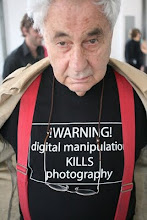



Amsterdam tijdens de hongerwinter.
Amsterdam / De Bezoge Bij/ Uitgeverij Contact / 1947 / First edition / 72 p. / cb. in wrappers / b&w photographs / NN / Buch / Zeitgeschichte, Zweiter Weltkrieg - Photographie - Anthologie - Nederland, Niederlande, Amsterdam - 20. Jahrh. - Andriesse, Emmy - Blazer, Carel - Breyer, Charles - Oorthuys, Cas - Taconis, Kryn - Windig, Ad
Amsterdam tijdens de hongerwinter by Martin Parr and Gerry Badger in : The Photobook: A History volume I
The book was published two years after the liberation of Holland from the Nazis. It marks both an end and a beginning. When it was published, the leading members of the Underground Camera group, like the country, were about to move on. As members of a new group, GKf, most of them took part in the exhibition 'Foto'48'. Amsterdam tijdens de hongerwinter looked back, while 'Foto'48' looked forward, but both shared a manifesto that made a passionate plea for an anti-formalist documentary photography that would help forge a more just and free Holland, following the occupation.
Thus this not simply a book remembering and commemorating Amsterdam's dreadful winter of 1944-5, but also a political rallying cry for the future. As the journalist Max Nord wrote in the book's introduction: 'Was it not those times that we dreamed our most beautiful dreams?...While uniformed Germans marched along Amsterdam's canals, their clipped songs resounding past the overcrowed prisons, we had a clear vision of the most perfect freedom.'
Nevertheless, the publication's first task was to bear witness, as photographers like Cas Oorthuys and Emmy Andriesse knew when they made these pictures, often at some risk. The story told is of extreme hardship - hunger, poverty and cold. People stand in food queues of search desperately for firewood, while others lie dead or dying on the streets. But, it also showed resilience and resistance: the forging of identity cards, the printing of underground magazines. Much of the book is shot in a style that could be ragarded as the opposite of formalist - not exactly anti-formalist, but a mode where the primary considerartion was getting the picture, no matter how out-of-focus or blurred it might have been. This snatched, off-kilter approach generated an immediate, spontaneous aesthetic of its own, which fed directly into postwar Dutch photography in an extremely positive way. So this was an important book in that sense also. It was a landmark publication by a group of photographers with both an ethical and an aesthetic attitude, a group who would exert a great influence on Dutch photography and the Dutch photobook in the late 1940s and 50s.
The book was published two years after the liberation of Holland from the Nazis. It marks both an end and a beginning. When it was published, the leading members of the Underground Camera group, like the country, were about to move on. As members of a new group, GKf, most of them took part in the exhibition 'Foto'48'. Amsterdam tijdens de hongerwinter looked back, while 'Foto'48' looked forward, but both shared a manifesto that made a passionate plea for an anti-formalist documentary photography that would help forge a more just and free Holland, following the occupation.
Thus this not simply a book remembering and commemorating Amsterdam's dreadful winter of 1944-5, but also a political rallying cry for the future. As the journalist Max Nord wrote in the book's introduction: 'Was it not those times that we dreamed our most beautiful dreams?...While uniformed Germans marched along Amsterdam's canals, their clipped songs resounding past the overcrowed prisons, we had a clear vision of the most perfect freedom.'
Nevertheless, the publication's first task was to bear witness, as photographers like Cas Oorthuys and Emmy Andriesse knew when they made these pictures, often at some risk. The story told is of extreme hardship - hunger, poverty and cold. People stand in food queues of search desperately for firewood, while others lie dead or dying on the streets. But, it also showed resilience and resistance: the forging of identity cards, the printing of underground magazines. Much of the book is shot in a style that could be ragarded as the opposite of formalist - not exactly anti-formalist, but a mode where the primary considerartion was getting the picture, no matter how out-of-focus or blurred it might have been. This snatched, off-kilter approach generated an immediate, spontaneous aesthetic of its own, which fed directly into postwar Dutch photography in an extremely positive way. So this was an important book in that sense also. It was a landmark publication by a group of photographers with both an ethical and an aesthetic attitude, a group who would exert a great influence on Dutch photography and the Dutch photobook in the late 1940s and 50s.















































